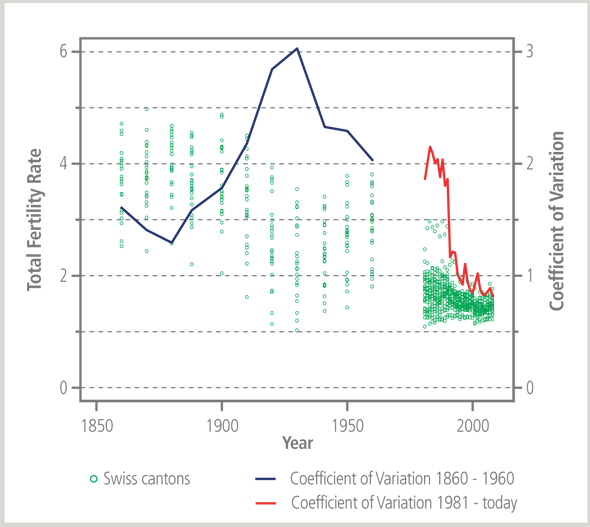April 10, 2013 | News | New Publication
Are more children born in the countryside than in the city?

Figure 1: The circles indicate the birth rates for individual Swiss catons. The degree to which these rates differ from one another regionally can be inferred from the so-called variation co-efficients, which are marked with a blue line for the years 1860 to 1960, and with a red line for the years 1980 to 2010. The data for 1860-1960 are based on estimates, and could have small errors. Source: Swiss Federal Statistical Office, Princeton European Fertility Project.
Like in Austria and Germany, this urban-rural gap reached its peak in Switzerland around the year 1920: at that time, the summarized birth rate of 1.3 children per woman in the urban canton of Basel-Stadt was only half as high as in the surrounding canton of Basel-Landschaft. But over the past 90 years, the differences between the two cantons have been shrinking, and today have almost disappeared. In Austria a similar ongoing decline in regional differences can be observed. In Germany, however, the picture is much less uniform as a result of the division of the country. In the latter decades of the 20th century, birth rates in eastern Germany went on a roller coaster ride, ranging from relatively high levels starting in 1975 to very low levels starting in 1990. Meanwhile, birth rates in western Germany have remained at low levels since the 1970s. However, starting in 1994, the birth rates in the different regions of Germany were once again in alignment. Klüsener has found similar convergence trends since the early 1990s in 15 out of 18 European countries.
This trend in recent decades toward a convergence in regional birth rates is not surprising. As a result of a number of factors—including the establishment of a uniform educational system, the spread of mass media, the equalization of living standards through social security benefits and the provision of economic support for structurally weak areas—the cultural, economic and social differences between the regions have been shrinking over the course of the last several decades. In addition, improvements in child care services have tended to make urbanized areas more attractive for families with children.
However, after taking a closer look at the federal states of Bremen and Lower Saxony, Sebastian Klüsener and his colleagues found that, parallel to this trend toward regional convergence, there appear to be certain developments that are moving in the opposite direction. Because the data at the level of the German federal states have been reported over relatively large areas since 1945, the demographers also compiled data on the birth rates for 28 areas in the city of Bremen and 255 areas in Lower Saxony for 1971 to 2006. A familiar pattern was found in Lower Saxony: although certain areas that have traditionally had especially high (Cloppenburg) or especially low (Harz region) birth rates relative to the national average were identified, even these differences declined considerably over the period studied.
The large-scale trend found for Germany, Austria and Switzerland was therefore reproduced on a small scale. The picture in Bremen is, however, very different, as the gaps between the birth rates in the various districts of the city of Bremen have risen sharply in recent decades. Klüsener attributed this development to a number of factors, including the likelihood that young women who are mostly childless university students choose to live in certain neighborhoods. Generally, an increasing concentration of people with similar social backgrounds seems to be taking place in cetain parts of the city. Thus, the birth rates between the various districts appear to be diverging, rather than converging. Klüsener believes this trend is occurring in other cities as well, and will likely continue in the years to come.